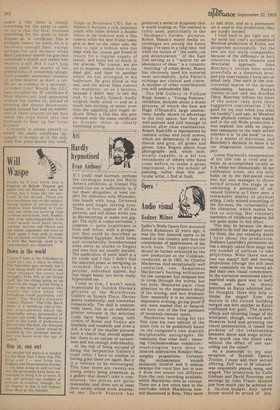Opera
Audio visual
Rodney Milnes,_.
_
Sadler's Wells Opera first mounted Katya Kabanova 22 years ago; it was the first Janacek opera to be heard in this country and thus the cornerstone of appreciation of his work here. This appreciation should be further enhanced by the new production at the Coliseum, conducted, as in 1951, by Charles Mackerras. And exceptionally well conducted, too. Sometimes Mackerras's burning enthusiasm for the composer has tempted him to romp through the scores, but not here. Measured pace, close attention to the expressive detail of the scoring, and taut dramatic flow: musically it is an extremely impressive evening, giving proof if any were needed that in Janacek we have one of the few geniuses of twentieth-century opera.
Mackerras was using for the first time his own edition of the score (yet to be published) based on the composer's own scarcely decipherable autographs. He maintains that what well meaning Czechoslovakian conductor!musicologists have done to Janacek approaches Rimsky/Mussorgsky proportions. Certainly the orchestration sounds brilliantly incisive and it seldom swamps the vocal line, but in sum it does not sound too different from the only recording available, which Mackerras cites as corrupt. There are a few extra bars in the interludes which Mackerras himself discovered in Brno. They seem to add little, and as a permanent set is used in this production, they are hardly needed.
I tried hard to put right out ot my mind last year's accomplished Wexford production of Katya, not altogether successfully. Yet the two are not really comparable, because of the difference in both resources in each theatre and directorial approach. John Blatchley's version here works powerfully at a theatrical level, and any reservations I have are on detail only. One such is the controversial matter of the deviant relationship between Katya's mother-in-law and the drunken Dikoj. Blatchley follows the letter of the score: they hold their suggestive conversation ("It's good for my soul when you treat me harshly") and exit. At Wexford some physical contact was stated, and in the old Wells production it was implied; this adds an important resonance to the main action. whether it is "in the book" or not. It is a matter of discretion, and Blatchley's decision to leave it to our imagination commands respect.
Lorna Haywood's interpretation of the title role is vivid and intense, as accomplished vocally as it is white-hot dramatically. In her confession scene, she not only holds on to the fast-paced vocal line but also manages to throw herself around the stage in as convincing a portrayal of advanced hysteria as I have seen: a remarkable display of physical acting. I only missed something of the fey-ness, the vulnerability of the character, which makes her fate so stirring. Her visionary narration of childhood dreams did not quite make its full effect.
This may be because the decor tended to do half the singers' work for them, the one sneaking doubt I have about the production. Stefanos Lazaridis's permanent set has a steeply raked false stage and any number .of surfaces to take projections. Were there one or two too many? Still and moving projections (though the still ones, were constantly on the move) added their own visual commentary. In the narration, mentioned above, marbled walls gave way to leafy trees, and then to thorny branches as Katya admitted lustful thoughts. Does this help or hinder the singer? Even the murals in the ruined building merged one into another as Katya confessed her guilt. The watery effects and recurring image of the whirlpool, though, worked well. However bold and arresting the visual presentation, it raised the problem of the relationship. between decor and stage action.. How much can the mind take without the effect of one cancelling out the other?
As a postscript to my sour reception of Scottish Opera's Tristan, I must add their second offering, Pell'eas et M'elisande, was exquisitely played, sung, and staged. The production by Colin Graham and David Pountney and settings by John Fraser showed just how much can be achived on a limited budget. Any opera house would be proud of this.


































 Previous page
Previous page